.gif)
Ford Granada (Europe)
Encyclopedia
The March 1972 released Granada succeeded the British Ford Zephyr
, and the German P7-series as Ford's European executive car
offering. At first, lower models in the range were called the Ford Consul
, but from 1975 on they were all called Granadas. The car soon became popular for taxi
, fleet and police usage. It was also converted into limousine
and hearse
versions by the British companies Coleman Milne
and Woodall Nicholson. Traditional four-door limousines were offered (both long and short versions) alongside an unusual four-door "coupé limousine" (only 12 built), as well as hearses in either two- or four-door configurations.

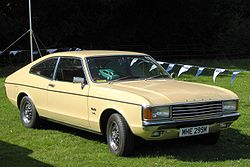
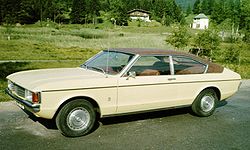 Mechanically, the European Granada conformed to Ford convention, the initial range using the Ford Essex V4 unit in 2.0 L displacement
Mechanically, the European Granada conformed to Ford convention, the initial range using the Ford Essex V4 unit in 2.0 L displacement
, and the "Essex" V6
engine in 2.5 and 3.0 L capacities. German models employed a Ford Taunus V4 engine
in 1.7 L displacement, or the 3.0L Essex V6, or, more commonly the "Cologne" V6
in 2.0, 2.3 or 2.6 L capacities. The V4
was later replaced by the Pinto
unit. The car generally followed mechanical layout of its predecessors Ford Zephyr/Zodiac
, utilizing a coil sprung independent rear end, although front McPherson struts were replaced by double wishbones, introduced 18 months earlier in smaller TC Cortina
and Taunus. On the other hand the Granada – like Ford 17M/20M/26M – featured drum brakes at rear, as opposed to the Ford Zephyr/Zodiac
rear disc brakes.
The cars were available as two- and four-door saloons, a five-door estate
(Turnier) and two-door fastback
coupé
. The early (1972–73) coupé had slightly different sheet metal; a more pronounced coke bottle styling
. In 1974 the coupé was revised, with more straight lines. The two-door-saloon was never sold or produced in the UK. A revised coupé was sold only in Ghia-trim in the UK; elsewhere in all trims with all engines available. This was the reverse of the situation with the TC Cortina
and Taunus
, where the British model had the "coke-bottle" styling.
In South Africa, the Granada Perana V8, built by Basil Green Motors
, was available through Ford dealers with the 302 CID Windsor V8
engine, developing 255 PS 405 newton metre at 2600 rpm.
engine in 2.0 L, 2.3 L and 2.8 L forms replacing the older "Essex" unit (which had never been offered in the Cologne built Granadas), and the introduction of features such as air conditioning
and, for the top price 2.8 litre versions, fuel-injection. In mainland Europe, a 1.7 L V4 was originally available. By the time of its introduction, UK Granada production had been quietly abandoned "for some time": UK market Granada IIs were imported from Germany. Internally within Ford, the "Cologne" 1.7, 2.0, 2.3 and 2.8 units were the last derivatives of the 'V-Taunus' range of engines.
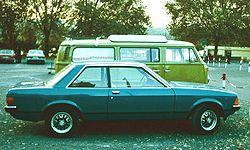
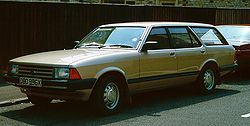 The coupé was discontinued when the new model began production, although there was a 2-door saloon version in certain European markets. A relatively low number of vehicles were also produced with the Peugeot 504
The coupé was discontinued when the new model began production, although there was a 2-door saloon version in certain European markets. A relatively low number of vehicles were also produced with the Peugeot 504
/ 505
four-cylinder diesel engine
in 1.9, 2.1 and 2.5 litre capacities. Originally only available as four-door sedans (the later 2.5 also as an estate), most of these went to taxi operators and few survive.
As the range matured another two models were introduced. A sports based Granada was introduced as the Granada 2.8 Injection which had white alloy wheels and a black bootlid spoiler. This model borrowed the 2.8i "injected" engine from the Ghia model range. Towards the end of its production run, the introduction of the 2.0 and 2.3 LX saloon and estate UK marketing packs provided versions with a slightly higher specification than the "base" L models.
A special Ford of Britain only marketing pack edition of the Ghia X model was later introduced as the "Ford Granada Ghia X Executive" which standardised luxury appointments such as the high grade Connolly Leather
interior that had previously been an optional fitment. Further refinements such an electric sunroof, electric opening boot on saloons, electric seat adjustment, heated seats, trip computer and air conditioning set the Granada Ghia X above most other cost comparable executive cars available in the UK in the early eighties. There was also a special "Taxi" edition, available only in black, which included a foot-operated "panic button" in the drivers' footwell which would operate the alarm system. In addition to these two models the range was complemented by estate models which reflected the same appointment levels as the entire saloon range including the Ghia X, but not the Ghia X Executive model.
in South Korea
for sales in that market, where it continued to be sold from October 1978 to 1986 when it gave way to the Hyundai Grandeur
instead of smaller European Fords like the Sierra and Escort. Production ended in December 1985, after 4,743 had been built. The car originally received a 2.0 liter V6 engine
with a 2-barrel Solex
carburetor
, but after 1980 the more economical 2 litre four-cylinder was also available. The Granada competed with the Saehan Rekord
as well as the Peugeot 604
, imported by Kia Motors
. Chung Mong-pil, the eldest son of Hyundai's founder Chung Ju-yung
, died in a car accident in a Granada.
Additionally, hearses were offered by outside conversion companies, as well as a series of four-door limousines built by Coleman Milne. These included the slightly stretched "Minster" 15 cm, and the 68 cm longer "Dorchester" and better equipped "Grosvenor". As of autumn 1982 the Dorchester was also available in an estate version with elongated rear doors, called the "Windsor".
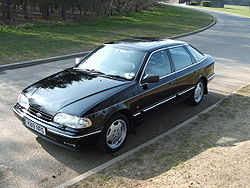 In April 1985 the third-generation car arrived, which was essentially a rebadged Ford Scorpio
In April 1985 the third-generation car arrived, which was essentially a rebadged Ford Scorpio
, the Granada name being used in the United Kingdom and Republic of Ireland
only, with the Scorpio badge (which covered the whole range in Continental Europe
) being reserved for the top-range versions. The Mark III Granada was the first European volume production model to have anti-lock brakes
fitted as standard across the range.
Engine options included the familiar SOHC Pinto engine, in either tax-barrier undercutting 1.8 L form, or a more powerful 2 litre version with fuel injection available. The Cologne V6 engines were carried over from the previous range in short-lived (and not much more powerful than the 2 L Pinto) 2.4 L, and 2.8 L (later 2.9 L) capacities. In 1991 A new range-topping vehicle was introduced, the Scorpio 24-valve. It featured a 2.9 L Cologne engine that had been extensively re-worked by Cosworth Engineering
and featured quad camshafts and 24 valves, enough for 200 bhp. According to Ford this gave a 0-60 mph time of 8.1 seconds and top speed of 140 mi/h.
This version of the Granada continued the "Ford family" styling concept from the previous versions; this time the car superficially resembled a larger version of the Cortina's successor, the Ford Sierra
.
The Ford Granada Mk III was the last car to car to bear the iconic Granada badge in the UK & Ireland being replaced in 1994 with the Pan-European Scorpio. The Scorpio shared its platform doors and roof with the Mk III Granada and these elements of the cars design were unremarkable. The styling of the nose and tail sections suffered from the application of the Ford Ovoid design school being used across the Ford range in the 1990s. On the Scorpio this appeared as a large gaping mouth, ‘bug’ eyed headlights and a bulbous boot. A 1998 redesign did nothing to save it from being axed the same year with total European sales only 95,587 units.
High end Ford ownership in Europe meant being able to afford performance and equipment levels which were otherwise the preserve of premium brand vehicles at a far higher price. With the Scorpio Ford seemed to neglect this concept. Evidence of this can be seen when comparing the specification of a 1984 Ford Granada 2.8i Ghia X Executive designed in the 1970s and a Scorpio Ultima designed in the 1990s; the additional equipment for that decade-long gap is ABS, an airbag, and a CD player.
It should be acknowledged that most volume manufactures have, in common with Ford, failed to maintain a position in the executive car sector in Europe. With the Opel/Vauxhall Omega
, Citroën XM
, Peugeot 607
all being axed and not replaced. One cause of this is the increasing accessibility of premium BMW
and Mercedes
brands. As consumers become more aspirational is may be seen as more desirable to have even a lesser equipped luxury car than a well equipped volume car.
Ford Zephyr
The Ford Zephyr was a car manufactured by the Ford Motor Company in the United Kingdom. Between 1950 and 1972, it was sold as a more powerful six-cylinder saloon to complement the four-cylinder Ford Consul: from 1962 the Zephyr itself was offered in both four- and six-cylinder versions.The Zephyr...
, and the German P7-series as Ford's European executive car
Executive car
Executive car is a British term that refers to a car's size and is used to describe an automobile larger than a large family car. In official use, the term is adopted by EuroNCAP, a European organisation founded to test car safety.- History :...
offering. At first, lower models in the range were called the Ford Consul
Ford Consul
The Ford Consul is a car manufactured by Ford in Britain.Between 1951 and 1962 the Consul was the four-cylinder base model of the three-model Ford Zephyr range, comprising Consul, Zephyr and Zephyr Zodiac...
, but from 1975 on they were all called Granadas. The car soon became popular for taxi
Taxicab
A taxicab, also taxi or cab, is a type of vehicle for hire with a driver, used by a single passenger or small group of passengers, often for a non-shared ride. A taxicab conveys passengers between locations of their choice...
, fleet and police usage. It was also converted into limousine
Limousine
A limousine is a luxury sedan or saloon car, especially one with a lengthened wheelbase or driven by a chauffeur. The chassis of a limousine may have been extended by the manufacturer or by an independent coachbuilder. These are called "stretch" limousines and are traditionally black or white....
and hearse
Hearse
A hearse is a funerary vehicle used to carry a coffin from a church or funeral home to a cemetery. In the funeral trade, hearses are often called funeral coaches.-History:...
versions by the British companies Coleman Milne
Coleman Milne
Coleman Milne is a coachbuilder in the UK that specialises in converting cars into funeral vehicles, stretched limousines, preparation of police vehicles and other specialist vehicles...
and Woodall Nicholson. Traditional four-door limousines were offered (both long and short versions) alongside an unusual four-door "coupé limousine" (only 12 built), as well as hearses in either two- or four-door configurations.



Engine displacement
Engine displacement is the volume swept by all the pistons inside the cylinders of an internal combustion engine in a single movement from top dead centre to bottom dead centre . It is commonly specified in cubic centimeters , litres , or cubic inches...
, and the "Essex" V6
Ford Essex V6 engine
Ford Motor Company has produced two different V6 piston engines which have been commonly referred to as Essex:* Ford Essex V6 engine - A 60° V6, 2.5/3.0 L* Ford Essex V6 engine - A 90° V6, 3.8-4.2 L...
engine in 2.5 and 3.0 L capacities. German models employed a Ford Taunus V4 engine
Ford Taunus V4 engine
The Taunus V4 was a V4 piston engine with one balance shaft, introduced by Ford Motor Company in Germany in 1962. The German V4 was built in the Cologne plant and powered the Ford Taunus and German versions of the Granada, Capri and Transit...
in 1.7 L displacement, or the 3.0L Essex V6, or, more commonly the "Cologne" V6
Ford Cologne V6 engine
The original Ford Cologne V6, also known as the 'Ford Taunus V6', is a series of 60° cast iron block V6 engines produced continuously by the Ford Motor Company in Cologne, Germany since 1968...
in 2.0, 2.3 or 2.6 L capacities. The V4
V4 engine
A V4 engine is a V form engine with four cylinders and three main bearings.-Automobile use:Lancia produced several narrow-angle V4 engines from the 1920s through 1960s for cars like the Lambda, Augusta, Artena, Aprilia, Ardea, Appia, and Fulvia....
was later replaced by the Pinto
Ford Pinto engine
The Ford Pinto engine was the unofficial but generic nickname for a 4-cylinder internal combustion engine built by Ford Europe. In Ford sales literature it was referred to as the EAO or OHC engine and because it was designed to the metric system, it was sometimes called the "Metric engine". The...
unit. The car generally followed mechanical layout of its predecessors Ford Zephyr/Zodiac
Ford Zephyr
The Ford Zephyr was a car manufactured by the Ford Motor Company in the United Kingdom. Between 1950 and 1972, it was sold as a more powerful six-cylinder saloon to complement the four-cylinder Ford Consul: from 1962 the Zephyr itself was offered in both four- and six-cylinder versions.The Zephyr...
, utilizing a coil sprung independent rear end, although front McPherson struts were replaced by double wishbones, introduced 18 months earlier in smaller TC Cortina
Ford Cortina
As the 1960s dawned, BMC were revelling in the success of their new Mini – the first successful true minicar to be built in Britain in the postwar era...
and Taunus. On the other hand the Granada – like Ford 17M/20M/26M – featured drum brakes at rear, as opposed to the Ford Zephyr/Zodiac
Ford Zephyr
The Ford Zephyr was a car manufactured by the Ford Motor Company in the United Kingdom. Between 1950 and 1972, it was sold as a more powerful six-cylinder saloon to complement the four-cylinder Ford Consul: from 1962 the Zephyr itself was offered in both four- and six-cylinder versions.The Zephyr...
rear disc brakes.
The cars were available as two- and four-door saloons, a five-door estate
Station wagon
A station wagon is a body style variant of a sedan/saloon with its roof extended rearward over a shared passenger/cargo volume with access at the back via a third or fifth door , instead of a trunk lid...
(Turnier) and two-door fastback
Fastback
A fastback is a car body style whose roofline slopes continuously down at the back. The word can also designate the car itself. The style is seen on two-door coupés as well as four-door sedans.-History:...
coupé
Coupé
A coupé or coupe is a closed car body style , the precise definition of which varies from manufacturer to manufacturer, and over time...
. The early (1972–73) coupé had slightly different sheet metal; a more pronounced coke bottle styling
Coke bottle styling
Coke bottle styling is a term used to describe any automotive body styling bearing an overall body shape resembling the classic glass Coca-Cola soft drink's contour bottle design. It is a style of automobile bodies with outward curving fenders with a narrow center. In contrast to "straight-edge"...
. In 1974 the coupé was revised, with more straight lines. The two-door-saloon was never sold or produced in the UK. A revised coupé was sold only in Ghia-trim in the UK; elsewhere in all trims with all engines available. This was the reverse of the situation with the TC Cortina
Ford Cortina
As the 1960s dawned, BMC were revelling in the success of their new Mini – the first successful true minicar to be built in Britain in the postwar era...
and Taunus
Ford Taunus
The Ford Taunus is a family car sold by Ford in Germany and other countries. Models from 1970 onward were similar to the Ford Cortina in the United Kingdom...
, where the British model had the "coke-bottle" styling.
In South Africa, the Granada Perana V8, built by Basil Green Motors
Basil Green Motors
Basil Green Motors is a former car manufacturer and rallye team who is located in Edenvale, Gauteng near Johannesburg, South Africa. Currently the company is active as a dealer of Ford and Mazda vehicles....
, was available through Ford dealers with the 302 CID Windsor V8
Ford Windsor engine
The Windsor is a 90-degree small-block V8 engine from Ford Motor Company. It was introduced in 1962, replacing the previous Ford Y-block engine. Though not all of the engines in this family were produced at the Windsor, Ontario engine plant , the name stuck...
engine, developing 255 PS 405 newton metre at 2600 rpm.
Ford Granada Mark II (1977–85)
The square and straight-lined Granada '78 appeared in August 1977 and was produced until April 1985 following a mild facelift and attention to drivetrain NVH in 1982. It was a development of the previous car, the main differences being the "Cologne" V6Ford Cologne V6 engine
The original Ford Cologne V6, also known as the 'Ford Taunus V6', is a series of 60° cast iron block V6 engines produced continuously by the Ford Motor Company in Cologne, Germany since 1968...
engine in 2.0 L, 2.3 L and 2.8 L forms replacing the older "Essex" unit (which had never been offered in the Cologne built Granadas), and the introduction of features such as air conditioning
Air conditioning
An air conditioner is a home appliance, system, or mechanism designed to dehumidify and extract heat from an area. The cooling is done using a simple refrigeration cycle...
and, for the top price 2.8 litre versions, fuel-injection. In mainland Europe, a 1.7 L V4 was originally available. By the time of its introduction, UK Granada production had been quietly abandoned "for some time": UK market Granada IIs were imported from Germany. Internally within Ford, the "Cologne" 1.7, 2.0, 2.3 and 2.8 units were the last derivatives of the 'V-Taunus' range of engines.


Peugeot 504
The Peugeot 504 is a large family car manufactured by French automaker Peugeot between 1968 and 1983, with licensed production continuing until 2006.-1968 — introduction:...
/ 505
Peugeot 505
The Peugeot 505 is a large family car produced by the French manufacturer Peugeot from 1979 to 1992 in Sochaux, France. The 505 was Peugeot's last rear-wheel drive car...
four-cylinder diesel engine
Diesel engine
A diesel engine is an internal combustion engine that uses the heat of compression to initiate ignition to burn the fuel, which is injected into the combustion chamber...
in 1.9, 2.1 and 2.5 litre capacities. Originally only available as four-door sedans (the later 2.5 also as an estate), most of these went to taxi operators and few survive.
As the range matured another two models were introduced. A sports based Granada was introduced as the Granada 2.8 Injection which had white alloy wheels and a black bootlid spoiler. This model borrowed the 2.8i "injected" engine from the Ghia model range. Towards the end of its production run, the introduction of the 2.0 and 2.3 LX saloon and estate UK marketing packs provided versions with a slightly higher specification than the "base" L models.
A special Ford of Britain only marketing pack edition of the Ghia X model was later introduced as the "Ford Granada Ghia X Executive" which standardised luxury appointments such as the high grade Connolly Leather
Connolly Leather
Connolly Leather was for over 125 years, a British company supplying highly finished leather primarily to car manufacturers. The term is also used to describe the particular brand of leather itself, when fitted in a car interior....
interior that had previously been an optional fitment. Further refinements such an electric sunroof, electric opening boot on saloons, electric seat adjustment, heated seats, trip computer and air conditioning set the Granada Ghia X above most other cost comparable executive cars available in the UK in the early eighties. There was also a special "Taxi" edition, available only in black, which included a foot-operated "panic button" in the drivers' footwell which would operate the alarm system. In addition to these two models the range was complemented by estate models which reflected the same appointment levels as the entire saloon range including the Ghia X, but not the Ghia X Executive model.
Special models
Ford subcontracted assembly to Hyundai Motor CompanyHyundai Motor Company
Hyundai Motor Company is a Korean multinational automaker based in Seoul, South Korea which, along with Kia, comprises the Hyundai Kia Automotive Group, the world's fourth largest automaker as of 2009. As of 2011, it is the world's fastest growing automaker for two years running...
in South Korea
South Korea
The Republic of Korea , , is a sovereign state in East Asia, located on the southern portion of the Korean Peninsula. It is neighbored by the People's Republic of China to the west, Japan to the east, North Korea to the north, and the East China Sea and Republic of China to the south...
for sales in that market, where it continued to be sold from October 1978 to 1986 when it gave way to the Hyundai Grandeur
Hyundai Grandeur
The New Grandeur and the third generation of the Mitsubishi Debonair were the products of a joint development between Hyundai and Mitsubishi Motors. Mitsubishi was responsible for the powertrain, and Hyundai was responsible for the body and trim design...
instead of smaller European Fords like the Sierra and Escort. Production ended in December 1985, after 4,743 had been built. The car originally received a 2.0 liter V6 engine
V6 engine
A V6 engine is a V engine with six cylinders mounted on the crankcase in two banks of three cylinders, usually set at either a right angle or an acute angle to each other, with all six pistons driving a common crankshaft...
with a 2-barrel Solex
Solex
Solex was a French manufacturer of carburetors and the powered bicycle VéloSoleX.The Solex company was founded by Marcel Mennesson and Maurice Goudard to manufacture vehicle radiators...
carburetor
Carburetor
A carburetor , carburettor, or carburetter is a device that blends air and fuel for an internal combustion engine. It is sometimes shortened to carb in North America and the United Kingdom....
, but after 1980 the more economical 2 litre four-cylinder was also available. The Granada competed with the Saehan Rekord
Daewoo Royale
The Daewoo Royale is a series of mid-size cars that was produced by Daewoo Motors in South Korea from 1983, being replaced by the Daewoo Prince in 1991, although production of the top-line Daewoo Imperial continued until 1993...
as well as the Peugeot 604
Peugeot 604
The Peugeot 604 is an executive car produced by the French manufacturer Peugeot from 1975 to 1985. 153,252 examples of the 604 were sold during its 10-year production life. It was made in France and also by Kia in Korea....
, imported by Kia Motors
Kia Motors
Kia Motors , headquartered in Seoul, is South Korea's second-largest automobile manufacturer, following the Hyundai Motor Company, with sales of over 1.4 million vehicles in 2010...
. Chung Mong-pil, the eldest son of Hyundai's founder Chung Ju-yung
Chung Ju-yung
Chung Ju-yung was a South Korean businessman and the the founder of Hyundai Group.-Early life:Chung Ju-yung was born in Tongchon, Kangwŏn province , during a time when Korea was under Japanese rule. Born to a large impoverished family of peasants, he was the oldest out of six children...
, died in a car accident in a Granada.
Additionally, hearses were offered by outside conversion companies, as well as a series of four-door limousines built by Coleman Milne. These included the slightly stretched "Minster" 15 cm, and the 68 cm longer "Dorchester" and better equipped "Grosvenor". As of autumn 1982 the Dorchester was also available in an estate version with elongated rear doors, called the "Windsor".
Ford Granada Mark III (1985–94)

Ford Scorpio
The Ford Scorpio is an automobile that was produced by the Ford Motor Company from 1985 through to 1998.It was the replacement for the European Ford Granada line...
, the Granada name being used in the United Kingdom and Republic of Ireland
Republic of Ireland
Ireland , described as the Republic of Ireland , is a sovereign state in Europe occupying approximately five-sixths of the island of the same name. Its capital is Dublin. Ireland, which had a population of 4.58 million in 2011, is a constitutional republic governed as a parliamentary democracy,...
only, with the Scorpio badge (which covered the whole range in Continental Europe
Continental Europe
Continental Europe, also referred to as mainland Europe or simply the Continent, is the continent of Europe, explicitly excluding European islands....
) being reserved for the top-range versions. The Mark III Granada was the first European volume production model to have anti-lock brakes
Anti-lock braking system
An anti-lock braking system is a safety system that allows the wheels on a motor vehicle to continue interacting tractively with the road surface as directed by driver steering inputs while braking, preventing the wheels from locking up and therefore avoiding skidding.An ABS generally offers...
fitted as standard across the range.
Engine options included the familiar SOHC Pinto engine, in either tax-barrier undercutting 1.8 L form, or a more powerful 2 litre version with fuel injection available. The Cologne V6 engines were carried over from the previous range in short-lived (and not much more powerful than the 2 L Pinto) 2.4 L, and 2.8 L (later 2.9 L) capacities. In 1991 A new range-topping vehicle was introduced, the Scorpio 24-valve. It featured a 2.9 L Cologne engine that had been extensively re-worked by Cosworth Engineering
Cosworth
Cosworth is a high performance engineering company founded in London in 1958, specialising in engines and electronics for automobile racing , mainstream automotive and defence industries...
and featured quad camshafts and 24 valves, enough for 200 bhp. According to Ford this gave a 0-60 mph time of 8.1 seconds and top speed of 140 mi/h.
This version of the Granada continued the "Ford family" styling concept from the previous versions; this time the car superficially resembled a larger version of the Cortina's successor, the Ford Sierra
Ford Sierra
The Ford Sierra is a large family car that was built by Ford Europe from 1982 until 1993. It was designed by Uwe Bahnsen, Robert Lutz and Patrick le Quément. The code used during development was "Project Toni"....
.
The Ford Granada Mk III was the last car to car to bear the iconic Granada badge in the UK & Ireland being replaced in 1994 with the Pan-European Scorpio. The Scorpio shared its platform doors and roof with the Mk III Granada and these elements of the cars design were unremarkable. The styling of the nose and tail sections suffered from the application of the Ford Ovoid design school being used across the Ford range in the 1990s. On the Scorpio this appeared as a large gaping mouth, ‘bug’ eyed headlights and a bulbous boot. A 1998 redesign did nothing to save it from being axed the same year with total European sales only 95,587 units.
Decline
Ford Europe had traditionally achieved success with the policy of minimal investment in an old model to launch an exciting, faster and better equipped new model. With the Scorpio (and the 1991 Escort) Ford seemed to get the investment balance wrong, which when allied to the unpopular styling caused their long term exit from this market segment in Europe.High end Ford ownership in Europe meant being able to afford performance and equipment levels which were otherwise the preserve of premium brand vehicles at a far higher price. With the Scorpio Ford seemed to neglect this concept. Evidence of this can be seen when comparing the specification of a 1984 Ford Granada 2.8i Ghia X Executive designed in the 1970s and a Scorpio Ultima designed in the 1990s; the additional equipment for that decade-long gap is ABS, an airbag, and a CD player.
It should be acknowledged that most volume manufactures have, in common with Ford, failed to maintain a position in the executive car sector in Europe. With the Opel/Vauxhall Omega
Opel Omega
The Opel Omega was an executive car marketed by the German automaker Opel between 1986 and 2003 in two generations, both manufactured at Opel's Rüsselsheim, Germany plant. The first generation, the Omega A , superseded the Opel Rekord, was voted European Car of the Year for 1987, and was available...
, Citroën XM
Citroën XM
The Citroën XM is an executive car that was produced by the French automaker Citroën between 1989 and 2000. Citroën sold 333,775 XMs during the model's 11 years of production...
, Peugeot 607
Peugeot 607
The Peugeot 607 was an executive car produced by the French automaker Peugeot from September 1999 to June 2010.The 607, along with the smaller 407, was superseded by the 508 in early 2011.-History:...
all being axed and not replaced. One cause of this is the increasing accessibility of premium BMW
BMW
Bayerische Motoren Werke AG is a German automobile, motorcycle and engine manufacturing company founded in 1916. It also owns and produces the Mini marque, and is the parent company of Rolls-Royce Motor Cars. BMW produces motorcycles under BMW Motorrad and Husqvarna brands...
and Mercedes
Mercedes
Mercedes is a girl's name of Spanish origin, referring to a title for the Virgin Mary, "Our Lady of Mercy". The word may also refer to:Automobile-related...
brands. As consumers become more aspirational is may be seen as more desirable to have even a lesser equipped luxury car than a well equipped volume car.

